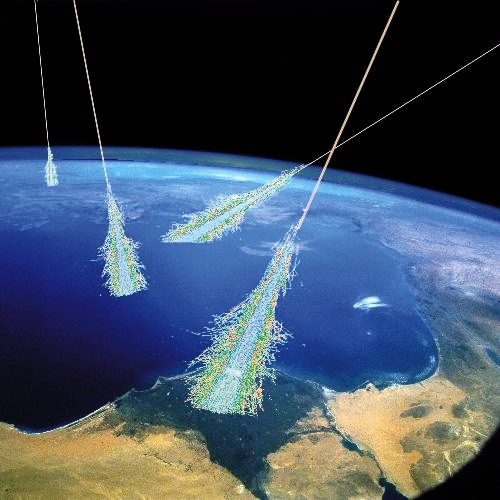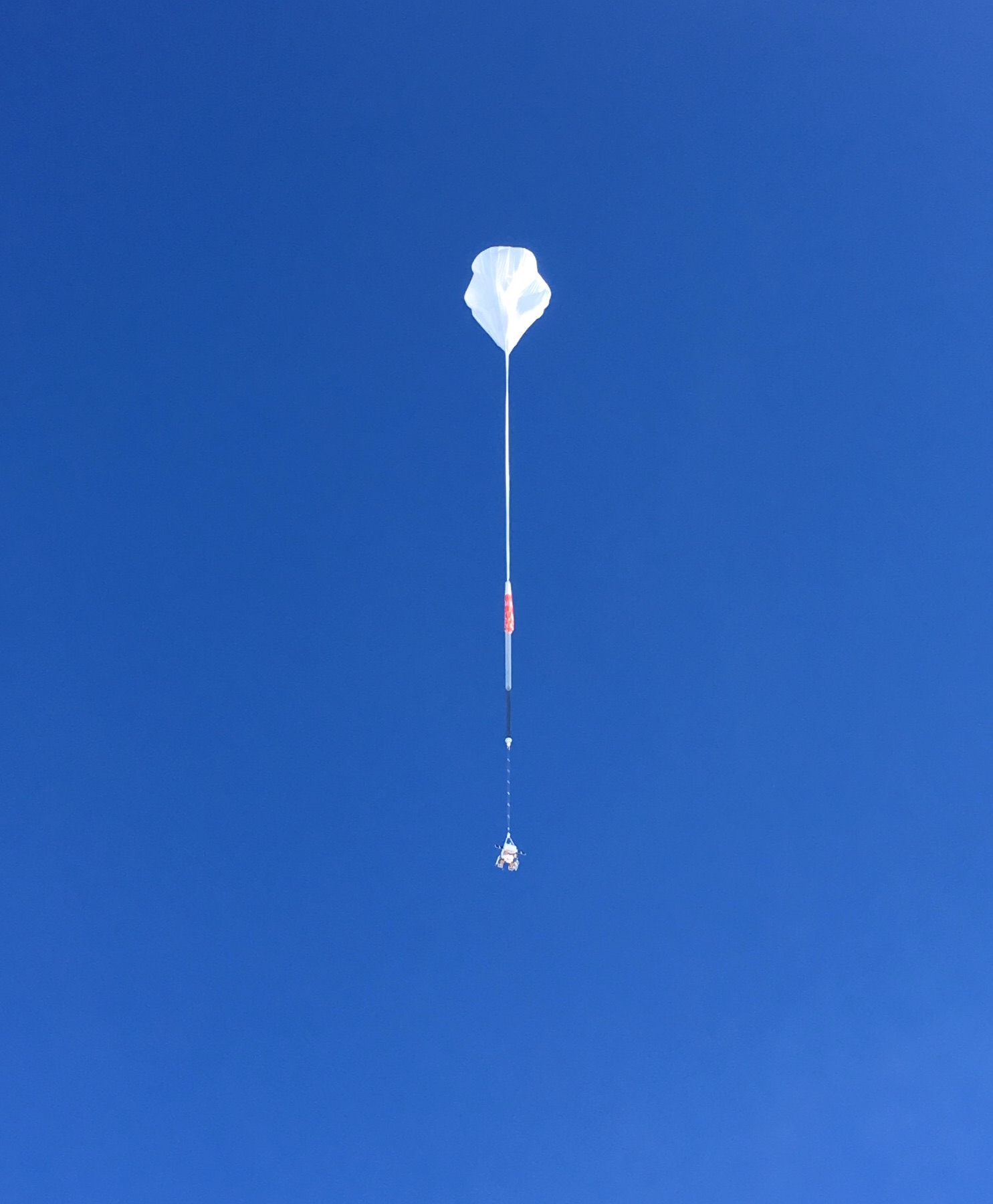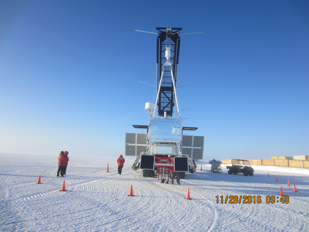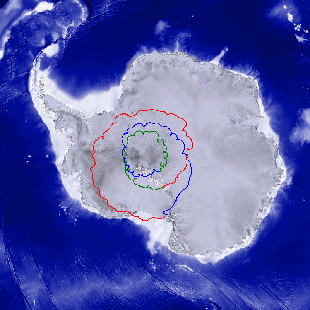High-flying Experiments Tackle the Mysteries of Cosmic Rays
Series of high-altitude balloon missions and upcoming space mission tackle enduring questions of physics
Cosmic rays are not rays at all, but highly energetic particles that zoom through space at nearly the speed of light. The particles range in size, from subatomic protons to the atomic nuclei of elements such as carbon and boron. Scientists suspect that the particles are bits of subatomic shrapnel produced by supernovae, but could also be signatures of other cataclysmic phenomena.
![Eun-Suk Seo, UMD professor of physics and head of the UMD Cosmic Ray Physics Group, stands in the on-campus control room where her students and technicians help monitor Long Duration Balloon (LDB) missions when they are underway in Antarctica. Behind her are [L-R]: postdoctoral research associate Jacob Smith, lab assistant Oluchi Ofoha, and undergraduate researcher Nathan Anthony. Image Credit: Faye Levine/UMD (Click image to download hi-res version.) Eun-Suk Seo, UMD professor of physics and head of the UMD Cosmic Ray Physics Group, stands in the on-campus control room where her students and technicians help monitor Long Duration Balloon (LDB) missions when they are underway in Antarctica. Behind her are [L-R]: postdoctoral research associate Jacob Smith, lab assistant Oluchi Ofoha, and undergraduate researcher Nathan Anthony. Image Credit: Faye Levine/UMD (Click image to download hi-res version.)](https://umd.box.com/shared/static/3memtvhi0yffq71vuhetsgayqsss3h32.jpg) Regardless of their origin, “cosmic rays are direct samples of matter from outside our solar system—possibly from the most distant reaches of the universe,” said Eun-Suk Seo, a professor of physics at the University of Maryland. Seo leads the Cosmic Ray Physics Group and has a joint appointment in the UMD Institute for Physical Science and Technology.
Regardless of their origin, “cosmic rays are direct samples of matter from outside our solar system—possibly from the most distant reaches of the universe,” said Eun-Suk Seo, a professor of physics at the University of Maryland. Seo leads the Cosmic Ray Physics Group and has a joint appointment in the UMD Institute for Physical Science and Technology.
For more than a decade, Seo’s research group has overseen a total of seven large-scale balloon missions in Antarctica dedicated to studying the nature of cosmic rays. This year, instruments designed and built by Seo’s group will journey to the International Space Station for a three-year mission to capture cosmic ray data beyond Earth’s atmosphere.
“The mysterious nature of cosmic rays serves as a reminder of just how little we know about our universe. The discovery of cosmic rays gave birth to the field of particle physics in the early 20th century. But no human-made particle accelerator can reach the energy levels we see in cosmic rays,” Seo added.
 Cosmic ray particles could help solve one of today’s most elusive scientific puzzles: determining the nature of dark matter. According to Seo, theory suggests that dark matter particles might collide and annihilate one another, resulting in energetic particles of conventional matter that we recognize as cosmic rays. If this theory is correct, studying cosmic rays could result in promising leads in the search for dark matter.
Cosmic ray particles could help solve one of today’s most elusive scientific puzzles: determining the nature of dark matter. According to Seo, theory suggests that dark matter particles might collide and annihilate one another, resulting in energetic particles of conventional matter that we recognize as cosmic rays. If this theory is correct, studying cosmic rays could result in promising leads in the search for dark matter.
When a cosmic ray particle reaches Earth’s atmosphere, it soon collides with another particle—most likely an atom of nitrogen or oxygen. This sets off a cascade of secondary particles that carry less energy than the original particle. The atmosphere serves as a protective filter, slowing down dangerous cosmic rays before they have a chance to damage life and property here on Earth’s surface.
But interference from the atmosphere also complicates the study of cosmic rays. To overcome this challenge, researchers try to minimize the amount of atmosphere between their instruments and arriving cosmic ray particles. Some groups build high-altitude ground-based observatories, such as the HAWC observatory located 13,500 feet above sea level in southern Mexico. But Seo and her research group aim even higher. They specialize in high-flying balloons that circle the continent of Antarctica at the upper edges of the atmosphere.
 These balloons, known as Long Duration Balloons (LDBs), are huge: the largest contain as much as 40 million cubic feet of helium and would nearly fill a football stadium when fully inflated. Each carries a payload of scientific instruments weighing up to 6,000 pounds, or about as much as a full-size SUV. Individual balloon flights last about a month at the height of the Southern summer in December and January.
These balloons, known as Long Duration Balloons (LDBs), are huge: the largest contain as much as 40 million cubic feet of helium and would nearly fill a football stadium when fully inflated. Each carries a payload of scientific instruments weighing up to 6,000 pounds, or about as much as a full-size SUV. Individual balloon flights last about a month at the height of the Southern summer in December and January.
“Antarctica provides an ideal platform for long-duration ballooning. In the summer, there is continuous daylight, so we don’t need to worry about the balloon losing altitude due to cooling of the gas inside,” Seo explained. “We can use solar power, avoiding the need for heavy batteries. We also don’t need to be concerned with political boundaries, as we would in the Northern Hemisphere.”
Seo’s team has successfully completed seven LDB missions, facilitated by NASA with additional support from the National Science Foundation. The first, known as Cosmic Ray Energetics and Mass I (CREAM I), launched in December 2004. CREAM I carried instruments to measure the energy, charge, mass and direction of incoming cosmic ray particles. The following five missions, also named CREAM and numbered II-VI, carried the same basic suite of instruments.
The CREAM missions were among the first to document a phenomenon known as “spectral hardening” in cosmic rays. Researchers expected that the rate of cosmic ray particles striking the CREAM detectors in a given timeframe—a measure called flux—would decrease constantly as energy levels increased. With spectral hardening, however, flux decreases much more slowly, meaning that the CREAM detectors observed more high energy cosmic rays than predicted.
CREAM’s detectors also observed differences in the behavior of two key types of particles, protons and helium. Paired with the spectral hardening results, this observation could support the idea that high energy cosmic rays and low energy cosmic rays may come from different sources, Seo said.
 The most recent mission is the first to carry a different name: Boron and Carbon Cosmic rays in the Upper Stratosphere (BACCUS). The flight set a record for the earliest seasonal launch in the history of the LDB program on November 28, 2016 and concluded 30 days later.
The most recent mission is the first to carry a different name: Boron and Carbon Cosmic rays in the Upper Stratosphere (BACCUS). The flight set a record for the earliest seasonal launch in the history of the LDB program on November 28, 2016 and concluded 30 days later.
The BACCUS mission set out to study the ratio of boron to carbon atoms hitting Earth’s atmosphere as cosmic rays. This ratio, along with measurements of the energy carried by each particle, could reveal fingerprints of a process called propagation that occurs outside the solar system in the interstellar medium, or the area between stars.
Cosmic rays tend to lose energy when they strike particles in Earth’s atmosphere. But physicists suspect that cosmic rays instead gain energy when they collide with interstellar matter, like a pinball striking a bumper. This energy enables the cosmic ray particle to propagate, or continue traveling at high speeds over great distances.
When the original cosmic ray particle is a carbon atom, a proton can be stripped away, forming a boron atom—and providing an important clue for researchers.
“In this case, carbon is the primary particle and boron is the secondary particle. This ratio of boron to carbon can give us important information about the process of propagation and the relationship between primary and secondary cosmic ray particles,” Seo added.
As energy levels increase, the ratio of boron to carbon particles tends to decrease. But so far, this has only been measured at lower energies. BACCUS was designed specifically to see how this relationship plays out at much higher energy levels.
 With the BACCUS flight now complete, Seo and her team have set their sights even higher. Sometime in 2017, an instrument modeled after the CREAM detector is scheduled to travel to the International Space Station. It will remain installed on the Japanese Experiment Module, also known as Kibo, for at least three years. The instrument, called ISS-CREAM, has to withstand a harsh environment far beyond that experienced during a balloon mission.
With the BACCUS flight now complete, Seo and her team have set their sights even higher. Sometime in 2017, an instrument modeled after the CREAM detector is scheduled to travel to the International Space Station. It will remain installed on the Japanese Experiment Module, also known as Kibo, for at least three years. The instrument, called ISS-CREAM, has to withstand a harsh environment far beyond that experienced during a balloon mission.
“ISS-CREAM has to survive a violent rocket launch. A balloon launch is very gentle by comparison,” Seo said. “ISS-CREAM also has to continue working without repairs for years, while a balloon instrument only needs to last a month or two. And any space-based experiment has to be shielded from radiation, which makes everything more expensive and the design processes more exacting.”
ISS-CREAM will carry a suite of instruments very similar to its balloon-borne cousins. But this time, the instruments will have direct, unimpeded access to incoming cosmic rays—with no atmospheric interference to contend with. Back on Earth, Seo’s team will monitor operations around the clock, taking shifts to ensure the instruments are properly calibrated and collecting the maximum amount of data.
Seo points out that the CREAM I-VI and BACCUS missions and the design phase for ISS-CREAM would never have been successful without a strong team of students and engineers. In addition to helping build and test most of the equipment for the LDB missions in Seo’s lab, students also help monitor every LDB flight from a control room on campus—24 hours a day, seven days a week—while the mission is underway.
“For any project, the most important thing is the people involved. People make things happen and are our most precious resource,” Seo said. “We’ve always had an A-team; there is no B-team. Everyone has strengths and weaknesses, and when you arrange these strengths the right way, every team is an A-team.”
###
Media Relations Contact: Matthew Wright, 301-405-9267, mewright@umd.edu
University of Maryland
College of Computer, Mathematical, and Natural Sciences
2300 Symons Hall
College Park, MD 20742
www.cmns.umd.edu
@UMDscience
About the College of Computer, Mathematical, and Natural Sciences
The College of Computer, Mathematical, and Natural Sciences at the University of Maryland educates more than 7,000 future scientific leaders in its undergraduate and graduate programs each year. The college's 10 departments and more than a dozen interdisciplinary research centers foster scientific discovery with annual sponsored research funding exceeding $150 million.







